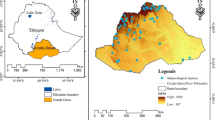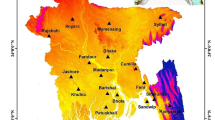Abstract
Knowledge about future rainfall is important for agriculture management and planning in arid and semi-arid regions. Australia has complex variations in rainfall patterns in time and space, arising from the combination of the geographic structure and the dual effects of Indian and Pacific Ocean. This study aims to develop a forecasting model of spatiotemporal monthly rainfall totals using lagged climate indices and historical rainfall data from 1950–2011 for south-eastern and eastern Australia. Data were obtained from the Australian Bureau of Meteorology (BoM) from 136 high-quality weather stations. To reduce spatial complexity, climate regionalization was used to divide the stations in homogenous sub-regions based on similarity of rainfall patterns and intensity using principal component analysis (PCA) and K-means clustering. Subsequently, a fuzzy ranking algorithm (FRA) was applied to the lagged climatic predictors and monthly rainfall in each sub-region to identify the best predictors. Selected predictors by FRA were found to vary by sub-region. After these two stages of pre-processing, an artificial neural network (ANN) model was developed and optimized separately for each sub-region and the entire area. The results indicate that climate regionalization can improve a monthly spatiotemporal rainfall forecast model. The location and number of sub-regions were important for ranking predictors and modeling. This further suggests that the impact of climate variables on Australian rainfall is more variable in both time and space than indicated thus far.













Similar content being viewed by others
References
Anwar MR, O’Leary G, McNeil D, Hossain H, Nelson R (2007) Climate change impact on rainfed wheat in south-eastern Australia. Field Crop Res 104(1–3):139–147
Anwar MR, Rodriguez D, Liu DL, Power S, O’Leary GJ (2008) Quality and potential utility of ENSO-based forecasts of spring rainfall and wheat yield in south-eastern Australia. Aust J Agric Res 59(2):112–126
Ashok K, Guan ZY, Yamagata T (2003a) Influence of the Indian Ocean Dipole on the Australian winter rainfall. Geophys Res Lett 30(15)
Ashok K, Guan ZY, Yamagata T (2003b) A look at the relationship between the ENSO and the Indian Ocean Dipole. J Meteorol Soc Jpn 81(1):41–56
Bannayan M, Lotfabadi SS, Sanjani S, Mohamadian A, Aghaalikhani M (2011) Effects of precipitation and temperature on crop production variability in northeast Iran. Int J Biometeorol 55(3):387–401
Cai W, Whetton PH, Pittock AB (2001) Fluctuations of the relationship between ENSO and northeast Australian rainfall. Clim Dyn 17(5-6):421–432
Cai W, Cowan T, Sullivan A (2009) Recent unprecedented skewness towards positive Indian Ocean Dipole occurrences and its impact on Australian rainfall. Geophys Res Lett 36(11), L11705
Cai W, van Rensch P, Cowan T, Hendon HH (2012) An asymmetry in the IOD and ENSO teleconnection pathway and its impact on Australian climate. J Clim 25(18):6318–6329
Chiew FHS, Zhou SL, McMahon TA (2003) Use of seasonal streamflow forecasts in water resources management. J Hydrol 270(1-2):135–144
Corte-Real J, Qian BD, Xu H (1998) Regional climate change in Portugal: precipitation variability associated with large-scale atmospheric circulation. Int J Climatol 18(6):619–635
Dezfuli AK (2011) Spatio-temporal variability of seasonal rainfall in western equatorial Africa. Theor Appl Climatol 104(1-2):57–69
Dezfuli AK, Karamouz M, Araghinejad S (2010) On the relationship of regional meteorological drought with SOI and NAO over southwest Iran. Theor Appl Climatol 100(1-2):57–66
Drosdowsky W (1993) An analysis of Australian seasonal rainfall anomalies 1950-1987: spatial patterns. Int J Climatol 13(1):1–30
Drosdowsky W (2002) SST phases and Australian rainfall. Aust Meteorol Mag 51(1):1–12
Drosdowsky W, Chambers LE (2001) Near-global sea surface temperature anomalies as predictors of Australian seasonal rainfall. J Clim 14(7):1677–1687
Fawcett RJB, Jones DA, Beard GS (2005) A verification of publicly issued seasonal forecasts issued by the Australian Bureau of Meteorology: 1998-2003. Aust Meteorol Mag 54(1):1–13
Gardner MW, Dorling SR (1998) Artificial neural networks (the multilayer perceptron)—a review of applications in the atmospheric sciences. Atmos Environ 32(14-15):2627–2636
Gerstengarbe FW, Werner PC, Fraedrich K (1999) Applying non-hierarchical cluster analysis algorithms to climate classification: some problems and their solution. Theor Appl Climatol 64(3-4):143–150
Gong XF, Richman MB (1995) On the application of cluster analysis to growing season precipitation data in north-America east of. Rockies Journal of Climate 8(4):897–931
Goovaerts P (2000) Geostatistical approaches for incorporating elevation into the spatial interpolation of rainfall. J Hydrol 228(1-2):113–129
Govindaraju RS (2000a) Artificial neural networks in hydrology. I: preliminary concepts. J Hydrol Eng 5(2):115–123
Govindaraju RS (2000b) Artificial neural networks in hydrology. II: hydrologic applications. J Hydrol Eng 5(2):124–137
Hagan MT, Menhaj MB (1994) Training feedforward networks with the Marquardt algorithm. IEEE Trans Neural Netw 5(6):989–993
Hendon HH, Thompson DWJ, Wheeler MC (2007) Australian rainfall and surface temperature variations associated with the Southern Hemisphere annular mode. J Clim 20(11):2452–2467
Hotelling H (1933) Analysis of a complex of statistical variables into principal components. J Educ Psychol 24:417–441
Hou Y, Zurada JA, Karwowski W, Marras WS, Davis K (2007) Identification of key variables using fuzzy average with fuzzy cluster distribution. IEEE Trans Fuzzy Syst 15(4):673–685
Johnson DE (1998) Applied multivariate methods for data analysts. Duxbury Press
Keogh E, Kasetty S (2003) On the need for time series data mining benchmarks: a survey and empirical demonstration. Data Min Knowl Disc 7(4):349–371
Kirono DGC, Chiew FHS, Kent DM (2010) Identification of best predictors for forecasting seasonal rainfall and runoff in Australia. Hydrol Process 24(10):1237–1247
Kottek M, Grieser J, Beck C, Rudolf B, Rubel F (2006) World map of the Koppen-Geiger climate classification updated. Meteorol Z 15(3):259–263
Lin YH, Cunningham GA, Coggeshall SV (1996) Input variable identification—Fuzzy curves and fuzzy surfaces. Fuzzy Sets Syst 82(1):65–71
Lund R, Li B (2009) Revisiting climate region definitions via clustering. J Clim 22(7):1787–1800
McBride JL, Nicholls N (1983) Seasonal relationships between Australian rainfall and the southern oscillation. Mon Weather Rev 111(10):1998–2004
McIntosh PC, Pook MJ, Risbey JS, Lisson SN, Rebbeck M (2007) Seasonal climate forecasts for agriculture: towards better understanding and value. Field Crop Res 104(1-3):130–138
Mekanik F, Imteaz MA, Ieee (2012) Forecasting Victorian spring rainfall using ENSO and IOD: a comparison of linear multiple regression and nonlinear ANN. 2012 2nd International Conference on Uncertainty Reasoning and Knowledge Engineering, 86-89 pp
Meneghini B, Simmonds I, Smith IN (2007) Association between Australian rainfall and the Southern Annular Mode. Int J Climatol 27(1):109–121
Meyers G, McIntosh P, Pigot L, Pook M (2007) The years of El Nino, La Nina, and interactions with the tropical Indian ocean. J Clim 20(13):2872–2880
Munoz-Diaz D, Rodrigo FS (2004) Spatio-temporal patterns of seasonal rainfall in Spain (1912-2000) using cluster and principal component analysis: comparison. Ann Geophys 22(5):1435–1448
Murphy BF, Timbal B (2008) A review of recent climate variability and climate change in southeastern Australia. Int J Climatol 28(7):859–879
Nicholls N (1983) The southern oscillation and Indonesian sea surface temperature
Nicholls N (2010) Local and remote causes of the southern Australian autumn-winter rainfall decline, 1958-2007. Clim Dyn 34(6):835–845
Pearson K (1901) On lines and planes of closest fit to systems of points in space. Philos Mag 2(7-12):559–572
Peel MC, Finlayson BL, McMahon TA (2007) Updated world map of the Koppen-Geiger climate classification. Hydrol Earth Syst Sci 11(5):1633–1644
Piechota TC, Chiew FHS, Dracup JA, McMahon TA (1998) Seasonal streamflow forecasting in eastern Australia and the El Nino Southern Oscillation. Water Resour Res 34(11):3035–3044
Power S et al (1998) Australian temperature, Australian rainfall and the Southern Oscillation, 1910-1992: coherent variability and recent changes. Aust Meteorol Mag 47(2):85–101
Power S, Casey T, Folland C, Colman A, Mehta V (1999) Inter-decadal modulation of the impact of ENSO on Australia. Clim Dyn 15(5):319–324
Reusch DB, Alley RB (2002) Automatic weather stations and artificial neural networks: improving the instrumental record in West Antarctica. Mon Weather Rev 130(12):3037–3053
Risbey JS, Pook MJ, McIntosh PC, Wheeler MC, Hendon HH (2009) On the remote drivers of rainfall variability in Australia. Mon Weather Rev 137(10):3233–3253
Rogers JC (1990) Pattern of low-frequency monthly sea-level pressure variability (1899-1986) and associated wave cyclone frequencies. J Clim 3(12):1364–1379
Rogers JC, McHugh MJ (2002) On the separability of the North Atlantic oscillation and Arctic oscillation. Clim Dyn 19(7):599–608
Ropelewski CF, Jones PD (1987) An extension of the Tahaiti-Darwin Southern Oscilation Index. Mon Weather Rev 115(9):2161–2165
Ruiz JE, Cordery I, Sharma A (2007) Forecasting streamflows in Australia using the tropical Indo-Pacific thermocline as predictor. J Hydrol 341(3-4):156–164
Rumelhart DE, Mcclelland JL (1986) Parallel distributed processing: explorations in the microstructure of cognition. Volume 1. Foundations, Medium: X; Size: Pages: 564pp
Saji NH, Yamagata T (2003) Possible impacts of Indian Ocean Dipole mode events on global climate. Clim Res 25(2):151–169
Saji NH, Goswami BN, Vinayachandran PN, Yamagata T (1999) A dipole mode in the tropical Indian Ocean. Nature 401(6751):360–363
Schepen A, Wang QJ, Robertson D (2012a) Evidence for using lagged climate indices to forecast Australian seasonal rainfall. J Clim 25(4):1230–1246
Schepen A, Wang QJ, Robertson DE (2012b) Combining the strengths of statistical and dynamical modeling approaches for forecasting Australian seasonal rainfall. J Geophys Res Atmos 117(D20):20107. doi:10.1029/2012JD018011
Shi G et al (2008) Variability and trend of North West Australia rainfall: observations and coupled climate modeling. J Clim 21(12):2938–2959
Sivakumar MVK, Hansen J (2007) Climate prediction and agriculture: summary and the way forward. Climate Prediction and Agriculture 1–13. doi:10.1007/978-3-540-44650-7_1
Smith TM, Reynolds RW, Peterson TC, Lawrimore J (2008) Improvements to NOAA’s historical merged land-ocean surface temperature analysis (1880-2006). J Clim 21(10):2283–2296
Stanski HR, Wilson LJ, Burrows WR (1989) Survey of common verification methods in meteorology. World weather watch tech. Rep. 8, WMO/TD No. 358
Stone R, Auliciems A (1992) SOI phase relationships with rainfall in eastern Australia. Int J Climatol 12(6):625–636
Stone RC, Hammer GL, Marcussen T (1996) Prediction of global rainfall probabilities using phases of the southern oscillation index. Nature 384(6606):252–255
Tasadduq M, Rehman S, Bubshait K (2002) Application of neural networks for the prediction of hourly mean surface temperatures in Saudi Arabia. Renew Energy 25(4):545–554
Valle S, Li WH, Qin SJ (1999) Selection of the number of principal components: the variance of the reconstruction error criterion with a comparison to other methods. Ind Eng Chem Res 38(11):4389–4401
van Ogtrop FF, Vervoort RW, Heller GZ, Stasinopoulos DM, Rigby RA (2011) Long-range forecasting of intermittent streamflow. Hydrol Earth Syst Sci 15(11):3343–3354
Verdon DC, Franks SW (2005) Indian Ocean sea surface temperature variability and winter rainfall: Eastern Australia. Water Resour Res 41(9). doi:10.1029/2004WR003845
Villar JCE et al (2009) Spatio-temporal rainfall variability in the Amazon basin countries (Brazil, Peru, Bolivia, Colombia, and Ecuador). Int J Climatol 29(11):1574–1594
Wang G, Hendon HH (2007) Sensitivity of Australian rainfall to inter-El Nino variations. J Clim 20(16):4211–4226
Wang QJ, Schepen A, Robertson DE (2012) Merging seasonal rainfall forecasts from multiple statistical models through Bayesian model averaging. J Clim 25(16):5524–5537
Wilson LL, Lettenmaier DP, Skyllingstad E (1992) A hierarchical stochastic-model of large-scale atmospheric circulation patterns and multiple station daily precipitation. J Geophys Res-Atmos 97(D3):2791–2809
Zhao M, Hendon HH (2009) Representation and prediction of the Indian Ocean dipole in the POAMA seasonal forecast model. Q J R Meteorol Soc 135(639):337–352
Acknowledgments
The authors gratefully acknowledge funding for project provided by the Australian Research Council and Grain Growers Limited. The authors would like to thank to Dr. Floris Van Ogtrop for valuable discussions and advice.
Author information
Authors and Affiliations
Corresponding author
Rights and permissions
About this article
Cite this article
Montazerolghaem, M., Vervoort, W., Minasny, B. et al. Spatiotemporal monthly rainfall forecasts for south-eastern and eastern Australia using climatic indices. Theor Appl Climatol 124, 1045–1063 (2016). https://doi.org/10.1007/s00704-015-1457-3
Received:
Accepted:
Published:
Issue Date:
DOI: https://doi.org/10.1007/s00704-015-1457-3




